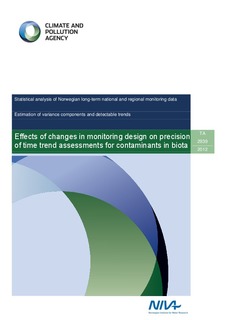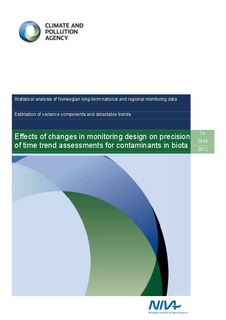| dc.contributor.author | Bjerkeng, B. | nb_NO |
| dc.contributor.other | Bjerkeng, B. - Project manager | nb_NO |
| dc.date.accessioned | 2014-08-01T10:57:25Z | |
| dc.date.available | 2014-08-01T10:57:25Z | |
| dc.date.issued | 2012 | nb_NO |
| dc.identifier | 6336 | nb_NO |
| dc.identifier.isbn | 978-82-577-6071-7 | nb_NO |
| dc.identifier.issn | 1894-7948 | nb_NO |
| dc.identifier.uri | http://hdl.handle.net/11250/215892 | |
| dc.description.abstract | Data from the Norwegian CEMP program has been used to analyse how the precision of trend assessments will be affected by changes in the monitoring program. Monitoring with two or three year intervals instead of annually will increase the minimum trend that can be detected with specified power and significance level by 50 to 100 % compared to yearly monitoring, based on trend detection with the current CEMP procedure. It cannot be generally recommended to decrease the monitoring frequency but it may be considered for stations where it is established that concentrations stays well below levels of any concern, and without any signs of upward trend over a number of years. Decreasing the sample size for cod liver from 25 to 20 fish would increase the minimum detectable trend with only 2-7 % (e.g. from 10 % to well within 11 % yearly change). Reduction to 15 fish would increase the minimum detectable trend by 3 to 22 %, less than 10 % for most stations and parameters. Analysing 25 fish as 5 batch samples of 5 fish each will give even less reduction of trend detection ability than reduction to 20 fish analysed individually. Even considering the uncertainty of these estimates, the general conclusion is that reductions in the cod liver program as described here will not reduce trend detection ability to an extent that it has practical significance. For areas where 3 or 4 repeated or distributed mussel sampling is done each year, a reduction to a single mussel sample per year may lead to a considerable reduction in trend detection ability (probably up to about 50 % increase in minimum detectable trend, possibly 80-90 %). A more cautious reduction to fewer samples, but still more than one, could probably be implemented without a large effect on the ability to detect trends. | nb_NO |
| dc.description.sponsorship | Klif | nb_NO |
| dc.publisher | Norsk institutt for vannforskning | nb_NO |
| dc.relation.ispartofseries | NIVA-rapport;6336 | nb_NO |
| dc.relation.ispartofseries | Overvåkingsrapport;TA-2939-2012 | nb_NO |
| dc.rights | Navngivelse-IkkeKommersiell-DelPåSammeVilkår 3.0 Norge | nb_NO |
| dc.rights.uri | http://creativecommons.org/licenses/by-nc-sa/3.0/no/ | nb_NO |
| dc.subject | marine ecology | nb_NO |
| dc.title | Effects of changes in monitoring design on precision of time trend assessments for contaminants in biota | nb_NO |
| dc.type | Research report | nb_NO |
| dc.rights.holder | Norsk institutt for vannforskning/Norwegian institute for water research | nb_NO |
| dc.subject.nsi | VDP::Matematikk og naturvitenskap: 400 | nb_NO |
| dc.source.pagenumber | 77 | nb_NO |
| dc.subject.keyword | miljøgifter | nb_NO |
| dc.subject.keyword | biota | nb_NO |
| dc.subject.keyword | marin | nb_NO |
| dc.subject.keyword | trendanalyse | nb_NO |
| dc.subject.keyword | contaminants | nb_NO |
| dc.subject.keyword | biota | nb_NO |
| dc.subject.keyword | marine | nb_NO |
| dc.subject.keyword | trend analysis | nb_NO |
| dc.relation.project | 11481 | nb_NO |


